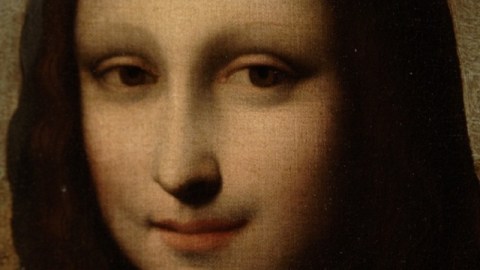Why You Shouldn’t Believe the “Earlier Mona Lisa” Hype

A second Mona Lisa? One made even earlier than the one hanging in the Louvre? It sounds almost too good to be true, and probably is. A Swiss-based organization calling itself The Mona Lisa Foundation launched a full-scale international media assault asserting that the painting formerly known as the Isleworth Mona Lisa is actually also by Leonardo da Vinci and is the long-presumed-lost “Earlier Mona Lisa” (detail shown above) alluded to in texts by Leonardo’s contemporaries. The idea that the most famous painting in the world suddenly has an older “sister” understandably sent a shockwave through not just the art world, but the world at large. But after the dust settles, the “Earlier Mona Lisa” is most likely neither earlier nor a Leonardo Lisa.
The Mona Lisa Foundation came into being in 2010 with the expressed mission of stating the case for taking this “Earlier Mona Lisa” seriously. Their website certainly impresses by its sheer size and depth. Subpages touting “Historical Evidence,” “Connoisseurship,” “Critical Comparisons,” “Physical & Scientific Examinations,” and “Provenance” seem to amount to a compelling case even before you click through them. If this is, as they claim, the culmination of 35 years of research, then maybe this really is the biggest art history story of the 21st century.
But take a little look closer and the cracks start to show. A closer look at the “Provenance” page—past the image-festooned timeline—will start you doubting. Yes, there are some references to a second painting in the writings of those who knew Leonardo, but nothing that suggests this painting is the one they’re talking about. The chain of evidence breaks completely for nearly a century and a half from 1590 through 1730 when, as the website explains, “[d]ue to turbulent times in Italy and France, no records of the painting’s whereabouts exist.” That’s a huge whole to cover over to make a convincing case. The timeline even marks the painting’s Wikipedia entry in 2002 as another “It must be true!” moment that falls short.
When they roll out a list of connoisseurs to support the case, it’s hard not to roll your eyes a bit. The key figure from this crew is Alessandro Vezzosi, Director of the Museo Ideale Leonardo da Vinci in Vinci, Italy. “Alessandro Vezzosi is recognized as one of the most influential living experts on Leonardo da Vinci,” the foundation helpfully explains, “and arguably the leading authority on Mona Lisa.” Vezzosi certainly looks stern and studious in the accompanying picture, but I’d like to argue that the global go-to da Vinci scholar remains British art historian Martin Kemp, who expresses his doubts over the “Earlier Mona Lisa” on his blog.
Kemp delivers a critical smack down of epic proportions on the Mona Lisa Foundation, whose media assault Kemp calls “an extraordinary bout of self-serving promotion.” Kemp admits that he hasn’t seen the painting in person, but he has viewed high-res images and, perhaps more importantly, read the book the foundation claims contains their airtight case. “I have not seen the painting in the original,” Kemp says, “but some things are so clear from the image and from their mish-mash of suppositions in the book that seeing the original is most unlikely to change my present conclusions.” Kemp calls the book “as physically impressive as it is historically slippery,” with “piles of unstable hypotheses, stacked one on another, [that] would not be acceptable from an undergraduate.”
Kemps flunks the foundation first on their tenuous use of the written sources, one of which mourned the end of da Vinci’s painting with the paralysis of the master’s right hand. Since Leonardo was left-handed, that source probably didn’t have the insider knowledge the foundation needs to credit him with to make their case.
Kemp boils down the scientific “evidence” to a claim that “that none of the evidence of scientific examination indicates that the Isleworth picture is not by Leonardo. Nor does it show that it is not by Raphael.” Such salesmanlike double-speak helps generate a cloud of doubt around the whole painting. For Kemp, perhaps the biggest strike against the painting being an original Leonardo is the lack of revisions revealed by the x-ray imaging. da Vinci famously worked and reworked his paintings. If this is the “earlier” painting, shouldn’t it have more, not fewer signs of changes than the “later” painting in the Louvre?
What seems to offend Kemp the most about the foundation’s claim is the poor quality of the painting itself. He offers seven points where the Isleworth work falls short, and says he could have listed more. “The head in the Isleworth picture has been conventionally prettified in stock direction of the standard Renaissance image of the ‘beloved lady,’” Kemp writes. It’s not a younger Mona, he believes. It’s a more boringly conventional idea of the beautiful—perhaps the surest sign that this painting’s a copy made by a more conventional, less revolutionary artist than Leonardo.
What is there to gain from calling this the “Earlier Mona Lisa”? Book sales? Exhibition revenue? Could this painting—holed away in a Swiss bank vault for the last 40 years—end up on the auction block? Would someone buy the hype enough to buy a painting allegedly linked to the most famous, most priceless piece of art on Earth? If the real Mona Lisa is priceless, what price would this work command? Records might fall, if someone with the financial means fell for the hype.





